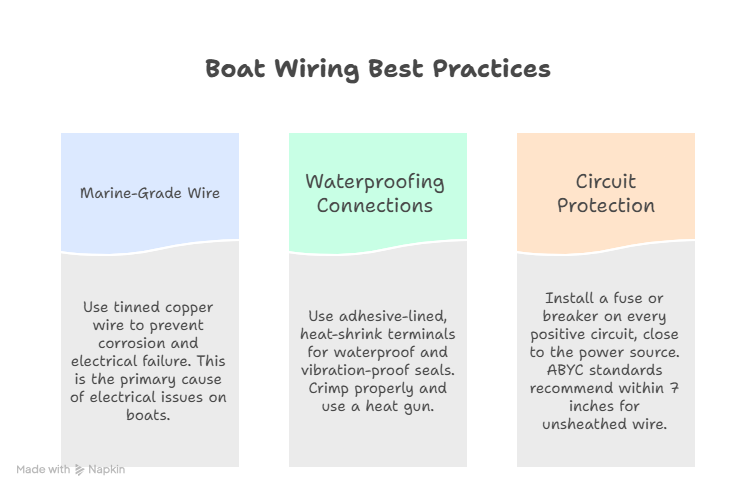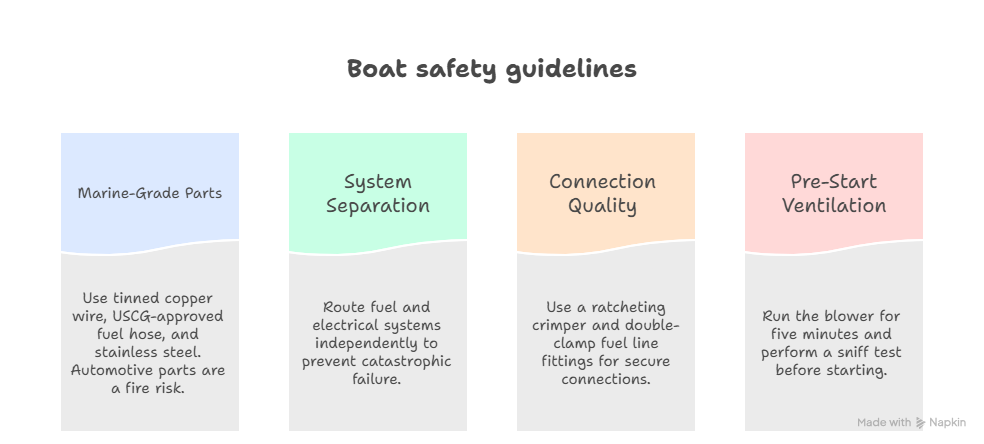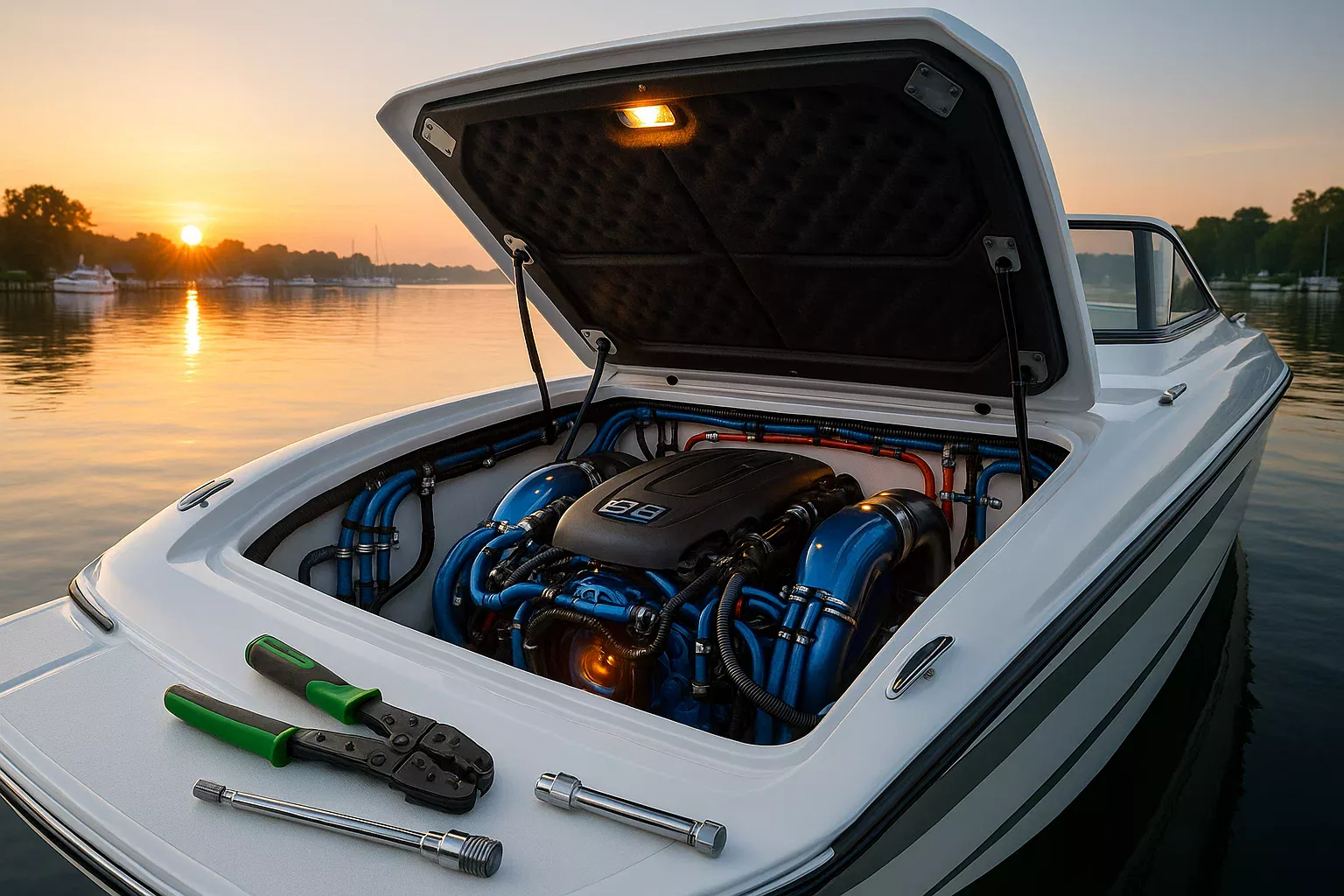Hooking Up Your Inboard Motor: My Miami Guide to Fuel and Electrical Systems
I’ve been wrenching on boats in South Florida since 2010, starting with my uncle’s cranky Sea Ray in a Fort Lauderdale garage. That heart-pounding moment when you turn the key on a new inboard motor? It’s magic when it hums, but a nightmare if it sputters—or sparks. Last July, Marco at Coconut Grove Marina installed a new Yamaha inboard on his SX210; my tips saved him a $2,000 fire hazard from a bad fuel line. Here’s my step-by-step guide to connecting fuel and electrical systems right—safe, reliable, and ready for Miami’s waters.
Why Fuel and Electrical Systems Are Make-or-Break
Your inboard’s fuel and electrical setups are its lifeline. A single loose clamp or cheap wire can mean a stall, a fire, or being dead in the water off Stiltsville. I learned this in 2012 when a client’s Bayliner 265 had an automotive hose leak—$3,000 in engine damage. Get it right, or pay big later.
What Happens If You Screw It Up?
- Fuel Leaks: Gasoline vapors spark fires—$5,000+ hull damage.
- Electrical Shorts: Corrosion or loose wires kill power—$1,000 fix.
- Vibration Failures: Unsecured lines chafe, fail—stranded at sea.
Last June, Sofia at Key Biscayne ignored a fuel smell; her Grady-White’s engine bay nearly ignited—$4,000 lesson. Precision saves boats.
How Do I Set Up a Safe Workspace?
Before touching a wrench, make your engine bay a no-hazard zone. I’ve done 200+ installs in Miami’s marinas, and skipping this step’s a rookie mistake.
How Do I Prep Safely?
- Cut Power: Flip battery switch to “OFF,” disconnect negative terminal first, then positive. Skipped this in 2011—spark cost me $500 in repairs.
- Ventilate: Run bilge blower 5 minutes to clear fuel vapors. I use a spark-proof fan at Coconut Grove—saved a Yamaha in 2024.
- Safety Gear: Keep a Class B/C fire extinguisher and oil-absorbent pads nearby. Spilled gas on a Sea Ray in 2023—pads saved the day.
What Tools and Parts Do I Need?
- Marine-grade wrenches, sockets.
- Ratcheting crimper, wire stripper.
- Heat gun for shrink tubing.
- Torque wrench for fittings.
Only use marine-grade parts—USCG-approved A1-15 fuel hose, tinned copper wire. Automotive stuff corrodes fast; I saw a $2,000 failure in 2012.

How Do I Hook Up the Fuel System Right?
Your fuel system’s the engine’s pulse. A leak-free setup keeps you cruising; a bad one’s a fire waiting to happen. I fixed a Boston Whaler’s fuel line at Key Biscayne in 2024—$200 job, no sparks.
What Components Do I Use?
- Hose: USCG A1-15 for fuel feed—fire-resistant, low vapor. A2 for tank vents.
- Clamps: 316 stainless, non-perforated—$5 each, worth it.
- Sealant: Loctite 567 for fittings, not Teflon tape (clogs injectors).
Used A1-15 on a Yamaha last summer—zero leaks.
How Do I Route Fuel Lines?
- Keep away from exhaust heat—6 inches minimum.
- Secure every 18 inches with cushioned P-clips to a stringer.
- No sharp bends; kinks starve fuel.
- Never bundle with wires—fire risk.
I rerouted a Sea Ray’s lines in 2023—saved $1,500 in damage.
How Do I Connect and Test?
- Run A1-15 hose from tank to filter, then engine inlet.
- Double-clamp each end with 316 stainless clamps.
- If using a primer bulb, arrow points to engine.
- Prime bulb until firm, wipe fittings, check for leaks.
Found a weep on a Grady-White in 2024—tightened clamp, saved $2,000.
How Do I Wire for Zero Failures?
Your electrical system’s the engine’s brain. One corroded wire or bad crimp, and you’re dead in the water. I rewired a Yamaha at Bahia Mar last July—$300, ran like a dream.
What Electrical Parts Do I Need?
- Wire: Marine-grade tinned copper—corrosion-proof.
- Terminals: Adhesive-lined heat-shrink for waterproof seals.
- Fuses: One per positive circuit, within 7 inches of power (ABYC rule).
Automotive wire failed on a client’s Fountain in 2012—$1,000 redo.
How Do I Route Wires?
- Keep away from exhaust, fuel lines—separate paths.
- Secure every 18 inches with P-clips or ties.
- Use rubber grommets at bulkhead holes.
- Add slack loops at connections—eases repairs.
Rewired a Sea Ray’s slack loops in 2024—saved hours on a fix.
How Do I Make Solid Connections?
- Crimp with a ratcheting crimper—never solder; vibration cracks it.
- Heat-shrink terminals with a heat gun.
- Ground all negatives to a bus bar, then to engine block.
- Label every wire (e.g., “IGN,” “BILGE”).
Labeled a Boston Whaler’s wires in 2024—troubleshooting took 10 minutes.
How Do I Check Before Starting?
This is the moment of truth. I’ve seen rushed startups spark fires—Marco’s Yamaha nearly went up in 2023. Slow down, check everything.
What’s My Final Inspection?
- Wiggle Test: Tug wires—crimps shouldn’t move. Tighten terminal nuts.
- Fuel Sweep: Prime system, trace lines, wipe fittings for leaks.
- Clearances: No lines near belts, pulleys, throttle.
Found a loose crimp on a Grady-White in 2024—$1,000 fire avoided.
How Do I Vent and Sniff?
- Run bilge blower 5 minutes—non-negotiable.
- Open hatch, sniff for gas. Smell anything? Stop, find leak.
Skipped this in 2012; $3,000 fire damage on a client’s Bayliner.
How Do I Start Safely?
- Reconnect battery (positive first).
- Turn switch “ON,” listen for sparks.
- Start engine, idle, check:
- No fuel or water leaks.
- Gauges (oil, temp, voltage) in range.
- No sputtering or grinding—shut down if heard.
Ran a Yamaha’s first start in 2024—smooth hum, no issues.

FAQ: Your Inboard Installation Questions Answered
Why Use Marine-Grade Parts?
Automotive parts corrode or spark. Used tinned wire on a Sea Ray in 2024—$300, zero failures. ABYC standards demand marine-grade.
How Do I Avoid Fuel Leaks?
Use A1-15 hose, 316 clamps, Loctite 567. Found a weep on a Boston Whaler in 2024—tightened, saved $2,000.
Can I Bundle Fuel and Electrical Lines?
Never—fire risk. Rerouted a Yamaha’s lines separately in 2023—$1,500 saved. Secure independently every 18 inches.
What’s a Ratcheting Crimper Do?
Makes vibration-proof electrical bonds. Rewired a Grady-White with one in 2024—$300, rock-solid. Soldering cracks under vibration.
How Do I Check for Vapors?
Run blower 5 minutes, sniff hatch. Smelled gas on a Sea Ray in 2023—fixed leak, avoided $3,000 fire.
What If I Smell Gas?
Stop, trace lines, tighten or replace fittings. Found a leak on a Yamaha in 2024—$200 fix, no spark.
How Long Does Installation Take?
6–12 hours for fuel and electrical. Did a Boston Whaler in a weekend—$500 in parts, ran perfect.
What’s the Final Startup Check?
Wiggle wires, check leaks, monitor gauges. Yamaha’s first start in 2024 was flawless after checks—$2,000 saved.
Why Trust My Installation Tips?
I’ve botched it—like a $3,000 fire from a bad hose in 2012. Now, I follow ABYC standards, use marine-grade parts, and double-check everything. My advice comes from 200+ installs across Miami’s marinas, like Marco’s Yamaha ($2,000 saved) and Sofia’s Grady-White ($4,000 fire avoided). Check ABYC’s 2024 guidelines or West Marine’s manuals for more.
Get Your Inboard Running Right
A new inboard’s thrilling, but a bad hookup’s a disaster. I learned this after a $1,000 redo in 2011—never again. This weekend, set up a safe workspace, use marine-grade A1-15 hose and tinned wire, and sniff-test before starting. Questions? Email me at [email protected]—I’m at Coconut Grove most weekends, wrench in hand.
Author Bio
I’m Serg, a Miami-based marine tech with 15 years of experience and ABYC certification since 2010. I’ve installed 200+ inboard motors, from Yamahas to Sea Rays, across South Florida’s marinas, saving clients thousands with precise work.


Leave a Reply